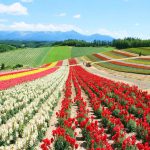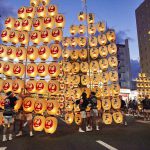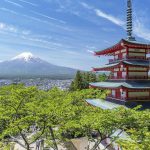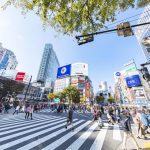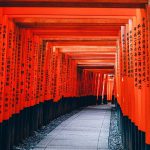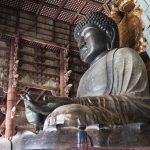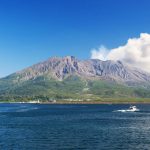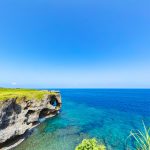Shikoku
The Shikoku region consists of four prefectures: Kagawa, Tokushima, Ehime, and Kochi, with the Seto Inland Sea to the north, and the Pacific Ocean to the south. The Seto Inland Sea side has a warm and dry climate, while the Pacific side is influenced by the Kuroshio Current, resulting in mild climate, even in the winter. By plane, Shikoku is about an hour and a half away from Tokyo, and about an hour from Osaka. In addition to airplane and ferry access, Shikoku and Honshu are connected by road and rail via the Honshu-Shikoku Bridges, consisting of three major routes.
Kagawa
Ritsurin Garden is a 400-year-old strolling garden that was originally created for the local feudal lord; it includes six ponds and 13 artificial hills in a vast area. It is one of the largest cultural property gardens in Japan, and has received the highest rating of three stars from the Michelin Green Guide Japan. Of all the ponds on the property, the South Pond is the most popular, where visitors may enjoy a 30-minute wasen (Japanese boat) ride.
Kotohiragu Shrine enshrines the god of the sea (known as Konpira), and since ancient times, is believed to bring abundant harvests of grain and prosperity of business. In the Edo period (1603-1867), it became a popular place of worship for many, including the common people, who made pilgrimages to visit the shrine. It is famous for its long path of 785 stone steps that lead to the main shrine. The total number of steps to the Okusha shrine is 1,368. On the way to the Omoteshoin, a national important cultural property, you can admire the fusuma (sliding panels) paintings of “Tsuru-no-ma” and “Tora-no-ma” by Maruyama Okyo, one of Japan’s representative painters; his masterful artwork is a must-see. After passing through the beautiful Asahi Shrine, you can climb the stairs to reach the main shrine, where you can enjoy the magnificent view. There are many Sanuki udon (a local signature dish) shops along the entry path to the shrine, so be sure to grab a bite to eat. Located on the backstreet from the main shrine is Japan’s oldest playhouse, the Konpira Grand Theater, also known as “Kanamaru-za.” Built in 1835, it has since been restored and Kabuki performances are still held today.
Located in the Seto Inland Sea, the island of Naoshima, with a circumference of about 16 km, is known as an island of contemporary art. Many art museums and galleries are located on the island, including the Chichu Art Museum built by Ando Tadao; Benesse House Museum; Lee Ufan Museum; ANDO MUSEUM; and the Art House Project, a showcase of houses and other structures that have been converted into art installations. The tranquil seascape of the Seto Inland Sea and relaxing pace of the island blend harmoniously with the art and architecture that surrounds you, creating a unique atmosphere, and making it a must-visit destination.
Tokushima
The Iya Gorge is one of the three least explored areas in Japan. It is a beautiful valley surrounding the Iya River that flows out of the 1,955-meter-high Mt. Kenzan. The view of the deep valley, with its 10-km-long sheer cliffs, is breathtaking. The 45-meter-long Iya-Kazura Bridge, made of woven vines, offers a thrilling experience of crossing over the river while viewing it through the gaps in the planks. The meandering river creates Hinoji (literally meaning the Japanese character of “hi”; due to its shape) Gorge, where the autumn foliage is spectacular.
Ochiai, located in Iya Gorge, is a village that has been in existence since the Edo period. The area is scattered with thatched-roof houses and fields built on a steep 390-meter slope that rises along a mountain. The buildings and stone walls are uniquely structured, and the original landscape has been preserved. The village is designated as an Important Preservation District of Historic Buildings.
To the west of the Iya Gorge are two neighboring gorges known as Oboke and Koboke created by the rapids of the Yoshino River. With its cherry blossoms, fresh greenery, and fall colors, it is a beautiful place to visit in any season. You can also enjoy river rafting or sightseeing by pleasure boat.
The Naruto Strait, which is sandwiched between Tokushima Prefecture and Awaji Island, is famous for the Naruto whirlpools created by the complex currents of the ocean. The powerful whirlpools can be seen up close on a cruise ship, and can also be seen from the glass floor of the promenade of the Naruto Bridge.
The Otsuka Museum of Art, located near the Naruto whirlpools cruise ship port, exhibits the reproductions of more than 1,000 Western masterpieces such as the Mona Lisa, Guernica, Sistine Chapel ceiling paintings, the Last Supper, and other Western masterpieces. The reproduced paintings are made of fired ceramic plates, and are the same size as the originals from more than 190 museums in 26 countries around the world.
Awa Odori is a dance festival that spans a 400-year history in Japan, and is held in various parts of Tokushima Prefecture. The largest of the Awa Odori festivals is in Tokushima City, which is held every year beginning on August 12. Awa Odori is held for four days, but the highlight of the festival is the So Odori (grand finale in which all of the dancers participate collectively), where as many as 1,000 male and female dancers perform to the music of drums, flutes and shamisen. The vision of dancing women with smiles on their faces, and wearing straw-woven hats of unique semicircular shape, is a truly beautiful and moving experience.
Ehime
Highlights of Matsuyama City, the capital of Ehime Prefecture, are Matsuyama Castle and Dogo Hot Springs. Built in 1602, Matsuyama Castle is one of the twelve original castles in Japan. The castle tower, built in the Edo period, still remains intact. It stands atop a 132-meter-high mountain, and offers a panoramic view of Matsuyama City and the Seto Inland Sea. The cherry blossoms are especially beautiful there in the springtime.
Dogo Onsen is a hot springs resort that appears in the Nihon Shoki (chronicles of Japan), and is said to have a history of over 3,000 years. The three-story wooden Dogo Hot Springs Main Building, built in 1897, is regarded as the model for Studio Ghibli’s “Spirited Away.”
Ozu, called the “Little Kyoto of Iyo,” is a castle town where samurai residences and old storehouses still remain. Garyu Sanso, a villa built on the banks of the Hijikawa River that flows through Ozu, is known as a masterpiece of Sukiya architecture. The view from the Furoan tea pavilion, which was built to appear as though it protrudes into the river, is so impressive that it was awarded a star in the Michelin Green Guide Japan. The town is also known for the Hijikawa Storm, an unusual natural phenomenon that creates a sea of clouds, seemingly flowing in one motion, along the Hijikawa River and into the ocean.
Ehime is also known for towels made in Imabari that is famous for its high-quality river water, and is Japan’s largest towel producing area. Uwajima is a city known for bullfighting and pearl cultivation. The Shimanami Kaido is an expressway that connects Honshu to Shikoku, and is the only route that allows bicycles. There are many places of interest for cyclists to enjoy along the chain of islands (Omishima, Hakatajima and Oshima) on the route. Also recommended is Omogokei, a beautiful gorge formed by the pristine headwaters of the Niyodo River.
Kochi
The 196-km-long Shimanto River, which flows to the west of Kochi Prefecture, is abundant in nature and referred to as the “last clear river in Japan,” because there are no dams upstream. The Shimanto River has 47 submersible bridges, which are built at the same level as the land, and sink when the water level rises. The bridges do not have any railing, reducing the risk of breaking when the water rises; it is an impressive demonstration of the wisdom utilized in building the bridges at a low cost, without sacrificing aesthetics that balance with the rich natural beauty of Shimanto. There are a variety of activities available, such as pleasure boat cruises, canoeing, and bicycle rentals.
Other rivers in Kochi known for their crystal transparency include the Niyodo River and Monobe River. The Niyodo River, which flows from the Shikoku Mountains, is very clear and unique in its distinct shade of blue, famously called “Niyodo Blue.” There are beautiful valleys in its upstream, and the mouth of the river, which flows into the sea, is known as one of Japan’s most popular surfing spots.
Kochi Castle is one of the twelve original castles in Japan; its construction was fully completed in 1611. It has a unique structure with a castle tower and palace inside the main compound.
The Yosakoi Festival is a four-day festival held every year from August 9 to 12, during which groups of dancers compete with each other. The dance styles vary, as well as the music, ranging from traditional to enka, rock, hip-hop, samba, hula, and more. The venues in Kochi City are filled with the excitement of the lively, energetic dancing.
Shikoku Pilgrimage
The pilgrimage to the 88 Buddhist temples in Shikoku that are associated with Kobo Daishi (also known as Kukai) is called “Shikoku henro,” and the pilgrims are called “Ohenro-san.” Typically, a pilgrim walks in a white robe or vest, wearing a hat, and carrying a walking stick. There are 23 sacred sites in Kagawa Prefecture; 23 in Tokushima Prefecture; 26 in Ehime Prefecture; and 16 in Kochi Prefecture. It is said that a pilgrim’s wish will be granted if he or she walks through the entire 1,400-km journey in about two months.


